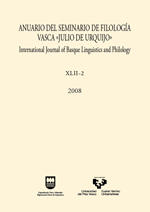C. C. Uhlenbeck's work on the Basque language
##plugins.themes.bootstrap3.article.main##
##plugins.themes.bootstrap3.article.sidebar##
Laburpena
C. C. Uhlenbeck worked on a wide variety of languages, but Basque is probably the language that was the most stable research interest throughout his career.
In recent years, many unknown facts about Uhlenbeck's life have been unearthed, especially in Eggermont-Molenaar (2005) and Genee and Hinrichs (2009) (see also Josselin de Jong 1953). Cornelius Christiaan Uhlenbeck (CCU) was born in Voorburg near The Hague in the Netherlands in 1866. His ancestors had emigrated from Germany in the 1700s and, after a period in Dutch colonies in Asia, settled in the Netherlands. CCU went to school in Haarlem and published a book of poems in that period. After graduation he went to Leyden to study Dutch, where he defended his dissertation in 1888, at age 21. He spent a year in Russia studying Russian documents relevant for the study of the history of the Netherlands. He taught at a high school, in the meantime working on linguistic issues, and he collaborated on the voluminous Woordenboek der Nederlandsche Taal ("Dictionary of the Dutch language"). In 1892 he was appointed professor in Sanskrit at the University of Amsterdam. In 1899 he became a professor of Old Germanic languages in Leyden, where he worked until his early retirement in 1926, at age 60, mostly for medical reasons. The summers of 1910 and 1911 he spent doing fieldwork on the Blackfoot language in Montana, USA, but for the most part Uhlenbeck was an armchair linguist, and avid reader who got most of his information from books. In 1936 he moved to Lugano, Switzerland, with his wife, where he died in 1951 at age 84. He had kept on writing and publishing on linguistics until the year of his death. His nearly 500 publications (Bakker & Hinrichs 2009) reveal a broad range of interests: genealogy, mythology, history and, within linguistics, Eskimo languages, Algonquian languages, Basque, Sanskrit, Old Germanic languages, and etymology, typology, language contact, morphology and language change.
Nola aipatu
##plugins.themes.bootstrap3.article.details##
Lan hau Creative Commons Aitortu-EzKomertziala-LanEratorririkGabe 4.0 Nazioartekoa lizentzia baten mende dago.


